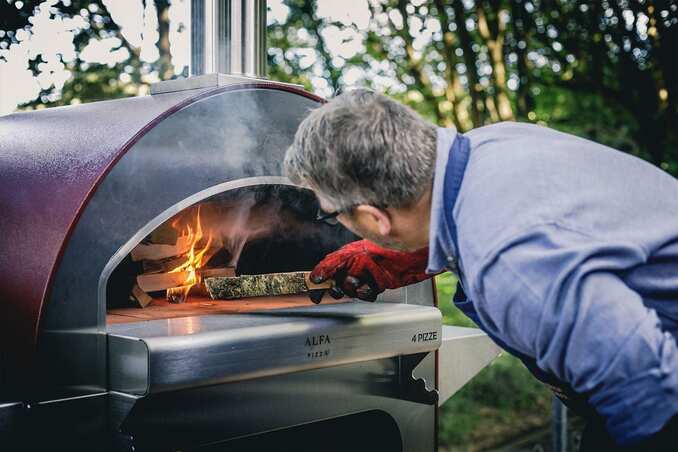When summer comes and you can’t wait to make the most of your outdoor space, buying an oven can give outdoor cooking a whole new meaning. Whether it be a masonry oven or a mobile one, professional-grade or family-oriented, it will help you take your cooking skills to the next level. In this article we will give you some tips to choose the best for you by pointing out the pros and cons of different type of ovens.
Outdoor wood-fired ovens vs home ovens
There is a variety of oven types with substantial differences in terms of design and construction which are classified by how they cook food or any other features they have. A first distinction concerns commercial ovens that are designed to deliver large quantities of food and to handle heavy use and home ovens that are smaller and less durable. According to the power source, they are categorized in wood-fired, gas-fired or electric ovens.

Wood-fired ovens
Traditional wood-fired brick ovens rely on firewood as their fuel source and can reach very high temperatures so that they are the pick of the bunch to liven up your outdoor living space with happening cooking parties.
Electric ovens
Electric ovens are the most popular option for your home kitchen. They are cheap, easy to use and suitable for the majority of baking needs given that they produce a more even heat.
Gas-fired ovens
Gas-fired ovens makes a good compromise as they are cheaper to run than the electric ones because they attain high temperatures rather quickly, are easy to install as they may be connected to the network or to a gas cylinder.
Pellet or hybrid ovens may be good alternatives as well.
Electric home ovens vs outdoor wood-fired ovens
Now, let’s see how outdoor wood-fired ovens stack up against electric home ovens.
1. Cooking
Wood-fired ovens reach very high temperatures and make it possible to cook Neapolitan pizza at 450°C (800°F) in just two minutes. Electric ovens cook almost anything you want as long as it doesn’t need a temp above 250°C (450°F).
2. Cooking quality
The wood imparts some smoky aroma to food which most people enjoy and that can vary according to the type of firewood. No such thing with an electric oven.
3. Use
A wood-burning oven is not made for everyday cooking while an electric one heats up and cools down very quickly providing even cooking through its cavity.
4. Maintenance and cleaning
A wood-fired oven requires more work after each use like removing food residues and clearing ash away.
5. Price
Many factors determine the oven price. Normally an electric oven costs less than an outdoor wood-fired oven. If you are a do-it-yourselfer and look for a bargain, build your own oven brick by brick or with modular kits.

Ten reasons to choose an outdoor wood-burning oven
1. Fire control
Fire control was the tipping point of human evolution. Taming fire allowed humans to stay warm, cook food, keep predators at bay and expand human activities. It’s in our DNA and there’s something in its smell, colour and sound that make you feel better and safer.
2. Temperature
A wood-fired oven can reach a temperature as high as 1 000°C (1 800° F) even though you won’t need so much heat to cook. These appliances need a few hours to heat up but once they are hot, they retain heat longtime. There are also wood-burning ovens with steel domes that reach cooking temperature more quickly. You can cook anything in a wood-fired oven by simply tweaking recipes a bit.
3. Smoky flavour
Cooking with wood gives food that smoky flavor that is impossible to recreate in standard ovens. The flavour changes according to the wood chosen. Better options include beech and oak, but olive or juniper are excellent too particularly for roasts.
4. A tool to develop your skills
Operating a wood-burning oven will test your cookery skills but with practice, patience and perseverance you will certainly end up mastering wood-fired cooking.
5. Any food tastes better
Anything you can make in a standard oven you can make it better in a wood-fired one. Food is cooked very quickly in it and as a result it retains all the nutrients that could be depleted with a longer cooking time.
6. Neapolitan pizza
Probably the main reason for buying a wood-fired oven. An authentic Neapolitan pizza must meet several requirements such as the dough that must be made with “tipo 0 or 00” wheat flour, much water (70% hydration), salt, yeast, then hand-kneaded and left to rise for 8 hours before baking it for 90 seconds at 450°C (800°F) in a wood-burning oven.
7. It expands and spices up your outdoor living space
Having an outdoor wood-burning oven adds to the value of your home and makes it into a place where your guests can gather and taste your scrumptious dishes.
8. Display cooking
Nothing beats a wood-burning oven when it comes to putting on a cooking show in front of your guests. Turn your outdoor space in theatre, socialising venue and restaurant all at once.
9. A long lifespan
A wood-fired oven is a worthy investment for the long run provided that you keep it in tip-top shape with regular cleaning and maintenance.
10. Eco-friendly
Wood-burning ovens are a low-carbon alternative to appliances using fossil fuels. They use a renewable and inexpensive fuel and burning wood doesn’t add to the carbon footprint.




